
The Second Australian Imperial Force was the name given to the volunteer personnel of the Australian Army in World War II. Under the Defence Act (1903), neither the part-time Militia nor the full-time Permanent Military Force (PMF) could serve outside Australia or its territories unless they volunteered to do so. The Second AIF fought against Nazi Germany, Italy, Vichy France and Japan. After the war, Australia's wartime military structures were demobilised and the 2nd AIF was disbanded, although a small cadre of its personnel became part of the Interim Army that was established in 1947, and from which the Australian Regular Army was formed in 1948.
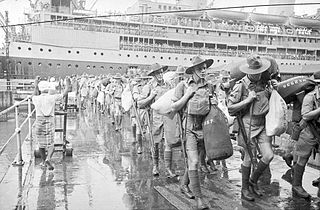
The 8th Division was an infantry division of the Australian Army, formed during World War II as part of the all-volunteer Second Australian Imperial Force. The 8th Division was raised from volunteers for overseas service from July 1940 onwards. Consisting of three infantry brigades, the intention had been to deploy the division to the Middle East to join the other Australian divisions, but as war with Japan loomed in 1941, the division was divided into four separate forces, which were deployed in different parts of the Asia-Pacific region. All of these formations were destroyed as fighting forces by the end of February 1942 during the fighting for Singapore, and in Rabaul, Ambon, and Timor. Most members of the division became prisoners of war, waiting until the war ended in late 1945 to be liberated. One in three died in captivity.

The Battle of Rabaul, also known by the Japanese as Operation R, was fought on the island of New Britain in the Australian Territory of New Guinea, in January and February 1942. It was a strategically significant defeat of Allied forces by Japan in the Pacific campaign of World War II, with the Japanese invasion force quickly overwhelming the small Australian garrison, the majority of which was either killed or captured. Hostilities on the neighbouring island of New Ireland are usually considered to be part of the same battle. Rabaul was significant because of its proximity to the Japanese territory of the Caroline Islands, site of a major Imperial Japanese Navy base on Truk.
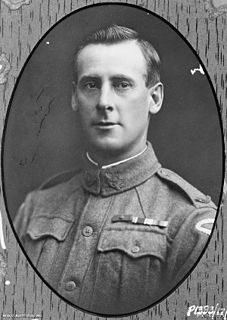
Walter "Wally" Peeler, was an Australian recipient of the Victoria Cross, the highest award for gallantry "in the face of the enemy" that can be awarded to members of the British and Commonwealth armed forces. He was decorated following his actions during the Battle of Broodseinde in October 1917. Then a lance corporal in the Australian Imperial Force, he repeatedly took the lead in the 37th Battalion's advance on well-defended German positions, destroying four machine gun posts and killing more than 30 German soldiers during the battle.

I Corps was an Australian Army corps, one of three that were raised by the Army during World War II. It was the main Australian operational corps for much of the war. Various Australian and other Allied divisions came under its control at different times. In 1940–1942, the corps was based in the Mediterranean and Middle Eastern theatres, and controlled forces in action against the Germans, Italians and later the Vichy French in North Africa, Greece and Syria–Lebanon.

Lieutenant Colonel William Taylor Owen was an Australian Army officer who served during the Second World War. A survivor of the Battle of Rabaul, he was killed in action leading the 39th Battalion during the Kokoda Track campaign.
Lark Force was an Australian Army formation established in March 1941 during World War II for service in New Britain and New Ireland. Under the command of Lieutenant Colonel John Scanlan, it was raised in Australia and deployed to Rabaul and Kavieng, aboard SS Katoomba, MV Neptuna and HMAT Zealandia, to defend their strategically important harbours and airfields.
The 2nd Brigade was a brigade-sized infantry unit of the Australian Army. Formed in 1903 as a militia formation based in Victoria, the brigade later served during the First World War as part of the Australian Imperial Force, allocated to the 1st Division. During the war, the 2nd Brigade took part in the fighting at Gallipoli, including the Battle of Krithia where it lost almost a third of its strength. Later they took part in the Battle of Lone Pine before being withdrawn back to Egypt in December 1915. Following this the brigade was transferred to the Western Front in France and Belgium where, between March 1916 and the armistice in November 1918, they took part in most of the major Allied operations.

The 2/40th Battalion was an infantry battalion of the Australian Army. Formed in mid-1940 from personnel recruited from Tasmania, the battalion was assigned to the 23rd Brigade, which formed part of the 8th Division. After completing basic training, the 2/40th was sent to Darwin to form part of the defensive garrison there as tensions with the Japanese grew throughout 1941. Following Japan's entry into the war, the battalion was deployed to Timor as part of Sparrow Force and in early 1942 they took part in the fighting on the island against the Japanese. Outnumbered and lacking supplies, the majority of the 2/40th's personnel were captured and spent the rest of the war as prisoners of war, although some were able to wage a guerrilla campaign across the island before being withdrawn by the end of year.
The 27th Brigade was a brigade-sized infantry unit of the Australian Army. The brigade was the last Second Australian Imperial Force infantry brigade raised for service during World War II. Initially assigned to the 9th Division, the brigade was transferred to the 8th Division shortly after it was raised. Training was undertaken around Bathurst, New South Wales throughout early 1941, before the brigade was sent to British Malaya in August 1941 to reinforce the 22nd Brigade, which had been dispatched earlier in the year. Following the Japanese invasion of Malaya, the brigade went into action in January 1942, taking part in the fighting along the western side of the Malay Peninsula. Its main action during this period came around Muar before the withdrawal to Singapore. In February, the brigade took part in the short lived Battle of Singapore. When the garrison surrendered on 15 February, the majority of the brigade's personnel were taken prisoner. They subsequently spent the remainder of the war in captivity before being released in August 1945.
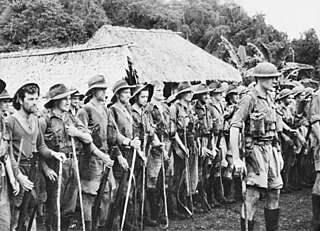
The 30th Brigade was a brigade-sized infantry unit of the Australian Army. Formed in December 1941, as part of the Militia, the unit was raised for service during the Second World War. Established in response to Japan's entry into the war, the brigade's subordinate units were established in several Australian states. Some of these had already been dispatched to New Guinea before the brigade's headquarters was established, although the majority arrived there in early 1942. Following their arrival, the brigade initially provided garrison troops to Port Moresby before later taking part in the fighting along the Kokoda Track during which elements took part in delaying actions around Kokoda and Isurava, before being relieved by units of the Second Australian Imperial Force. After the campaign began to turn in favour of the Australians, the Japanese withdrew north towards their beachheads around Buna and Gona, and elements of the brigade were recommitted to the fighting. In early 1943, the 30th Brigade was withdrawn back to Australia and was disbanded in July 1943, with its personnel being redistributed to other formations.
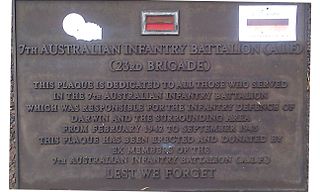
The 23rd Brigade was a brigade of the Australian Army. It was briefly raised in 1912 as a Militia formation providing training as part of the compulsory training scheme. Later, it was re-formed in July 1940 for service during the Second World War, the brigade was initially a formation of the Second Australian Imperial Force assigned to the 8th Division; however, after its sub units were captured by the Japanese in 1942 it was reformed with Militia battalions and was mainly used in a garrison role around Darwin, in the Northern Territory, until late in the war when it was committed to the fighting against the Japanese on Bougainville. It was disbanded in 1946.

The 22nd Brigade was a brigade-sized infantry unit of the Australian Army. It was briefly raised in 1912 as a Militia formation providing training as part of the compulsory training scheme. Later, during World War II, the brigade was raised as part of the all volunteer Second Australian Imperial Force in April 1940. Assigned to the 8th Division, in early 1941 the brigade was deployed to British Malaya where it formed part of the defensive garrison that was established there by the British, eventually establishing its headquarters in the Mersing–Endau area.

The 27th Battalion was an infantry battalion of the Australian Army. It was initially raised in 1915 as part of the all-volunteer First Australian Imperial Force for service during World War I. During the conflict, the battalion saw action briefly at Gallipoli before later fighting on the Western Front between 1916 and 1918. It was disbanded in 1919, but was re-raised in 1921 as part of the Citizens Force, which later became the "Militia". During World War II the battalion was used mainly in a garrison role until the last year of the war when it was committed to the fighting against the Japanese during the Bougainville campaign. Following the end of hostilities it was disbanded in May 1946. Between 1948 and 1965 the battalion was re-raised and disbanded a number of times before eventually becoming part of the Royal South Australia Regiment. It was disbanded for a final time in 1987, when it was amalgamated with the 10th Battalion, Royal South Australia Regiment to form the 10th/27th Battalion, Royal South Australia Regiment.
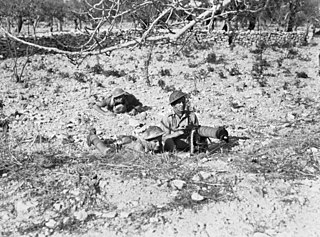
The 2/3rd Machine Gun Battalion was formed in June 1940 as part of the 7th Division and served in Egypt, Syria, the Netherlands East Indies and New Guinea during World War II. Under the command of Lieutenant Colonel Arthur Blackburn when it was raised, the battalion was primarily a South Australian unit, although it had sub-units formed in Victoria, Tasmania and Western Australia. After completing training in Australia, in April 1941 the battalion embarked for the Middle East. In June/July 1941 it saw action against Vichy French forces during the Syria–Lebanon campaign, during which time the battalion was heavily involved in supporting various elements of the 7th Division.

The 2/4th Machine Gun Battalion was an Australian Army unit raised for service with the all volunteer Second Australian Imperial Force during the Second World War. Formed in late 1940 as part of the 8th Division, the battalion was established to provide direct fire support to the division's infantry brigades. It was the fourth, and last, such unit raised within the 2nd AIF. The unit's personnel were largely drawn from the state of Western Australia and after formation, the battalion concentrated near Perth for basic individual training before moving to the Adelaide Hills to complete more advance manouevres.

The 2/29th Battalion was an infantry battalion of the Australian Army, which served during the Second World War. Formed in October 1940, the battalion served in Malaya as part of the 27th Brigade, which was assigned to the 8th Division. Recruited mainly from volunteers drawn from the state of Victoria, after completing its training around Bonegilla and then Bathurst, the 2/29th Battalion was sent to Malaya in August 1941 along with the rest of the 27th Brigade to bolster the Australian force there and subsequently fought in the Malayan Campaign following the Japanese attack in December 1941. The battalion fought several delaying actions along the west coast, including fighting around Bakri and Muar, and in Johore, before Allied forces withdrew across the Causeway to Singapore. The battalion later took part in the defence of Singapore in February 1942, but was captured after the garrison capitulated on 15 February. They spent the remainder of the war as prisoners of war, with many dying in captivity.

The 2/20th Battalion was an infantry battalion of the Australian Army. Raised in mid-1940 as part of the 8th Division, the battalion was recruited from Second Australian Imperial Force volunteers drawn from the state of New South Wales. In early 1941, the 2/20th Battalion deployed to Malaya, where they formed part of the garrison there until December when the Japanese invaded. The battalion subsequently fought a brief campaign along the east coast of the Malay Peninsula before being withdrawn back to Singapore in early 1942. They were heavily engaged after the Japanese landed on the island, and were eventually captured following the Fall of Singapore. Most members of the battalion became prisoners of war, and a large number died in captivity.
The 2/21st Battalion was an infantry battalion of the Australian Army. Raised for service during Second World War as part of the Second Australian Imperial Force, it was formed on 11 July 1940 at Trawool in central Victoria as part of the 23rd Brigade of the 8th Division. It was subsequently deployed to Ambon as part of Gull Force in December 1941 following the Japanese invasion of Malaya; however, with the defence of the island considered untenable due to the limited military resources available and overwhelming Japanese strength it was subsequently captured despite determined resistance, surrendering on 3 February 1942. Most members of the battalion became prisoners of war, and a large number died in captivity.
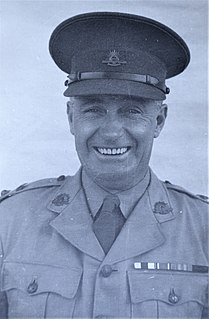
Lieutenant Colonel John Charles Robertson was a senior officer in the Australian Army who served in both the First and Second World Wars.

















